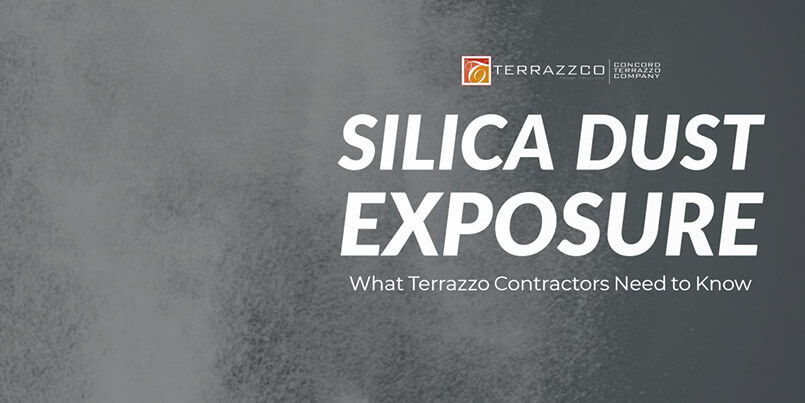05 Apr Silica Dust Exposure: What Terrazzo Contractors Need to Know

Silica Dust Exposure: What Terrazzo Contractors Need to Know
The Occupational Safety and Health Administration requires employers to protect their workers from exposure to respirable crystalline silica. The National Terrazzo and Mosaic Association provided a training course on the new standards and we will highlight what we learned.
What is Silica?
Silica, also known as silicon dioxide, is a colorless, white chemical compound making up the majority of the Earth’s crust. In fact, silica is the most common element today.
Is all silica dangerous? No. According to OSHA, amorphous silica is not a danger to the human body. Construction workers can work with glass and fumed silica and not have to worry about any chronic health conditions. OSHA is concerned about protecting workers from respirable crystalline silica.
What are the dangers of crystalline silica dust exposure?
Crystalline silica is dangerous when dispersed through the air. When working on a construction project, drilling, cutting, grinding, or chipping materials releases dust into the air, which contains crystalline silica particles. These dust particles are naked to the eye and are 100 times smaller than a grain of sand.
Diseases associated with crystalline silica exposure are silicosis and tuberculosis. Both are lung-related diseases. Studies have shown that many of the world’s population carries a gene for tuberculosis. However, exposure to crystalline silica increases the risk of people developing the disease by 25%. Silicosis is another lung disease that occurs when silica dust enters through one’s nose or mouth and travels to the lungs where the buildup of dust particles makes it difficult for one to breathe. It is described as if you were to breathe through a straw. Silica dust exposure is preventable, not curable.
How does this apply to terrazzo workers?
Terrazzo workers can expect to face these challenges during the preparation stages. OSHA recommends eliminating any procedures that lead to the formation of silica dust. However, terrazzo installers and manufacturers need to take precaution for the following steps of a terrazzo project:
- Preparation of concrete slab
- Mixing aggregates containing marble or granite
- Grinding the terrazzo floor
- Creating an underbed
OSHA’s New Limits
Terrazzo contractors must use certain measures to keep silica dust exposure below the Permissible Exposure Level (PEL). Today OSHA has listed the limit at 50 micrograms per cubic meter calculated as a time-weighted average over an 8-hour period. In cases where there is an over-limit, terrazzo workers must take certain measures to keep silica dust out of the air and into a worker’s lungs. Such measures include drinking water, setting up fans, or using exhaust ventilation like vacuums.
A competent person in the company has the authorization to eliminate or minimize silica dust if they identify silica dust hazards during the day.
Another measure used is the Action Level. An action level is a concentration of airborne respirable crystalline silica of 25 micrograms, calculated as a time-weighted average over an 8-hour period. If a terrazzo worker completes a task in under 15 minutes, they are exempt from testing. The goal is to remain under the action level to prevent testing. In cases where the action level is higher than normal, it is important to post signs up and have terrazzo workers try to bring the level down by using respirators, fans, or vacuums.
If medical testing is conducted, it is important for terrazzo workers to keep records of their past history of work. Medical tests include chest x-rays, spirometry tests, and TB tests.
For more information on silica dust exposure, you can visit their information site through this link: OSHA: Crystalline Silica Information






